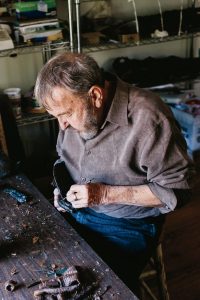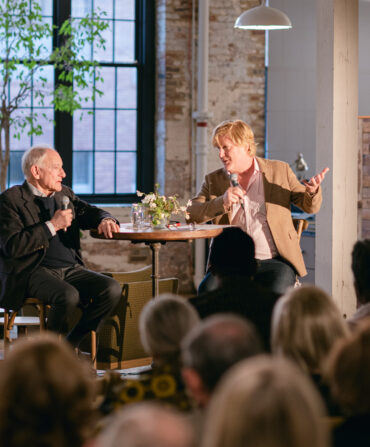Arts & Culture
The Fantastical World of Frank Fleming
How an Alabama sculptor eschewed the conventions of the art establishment, and in the process found beauty and his calling among the beasts
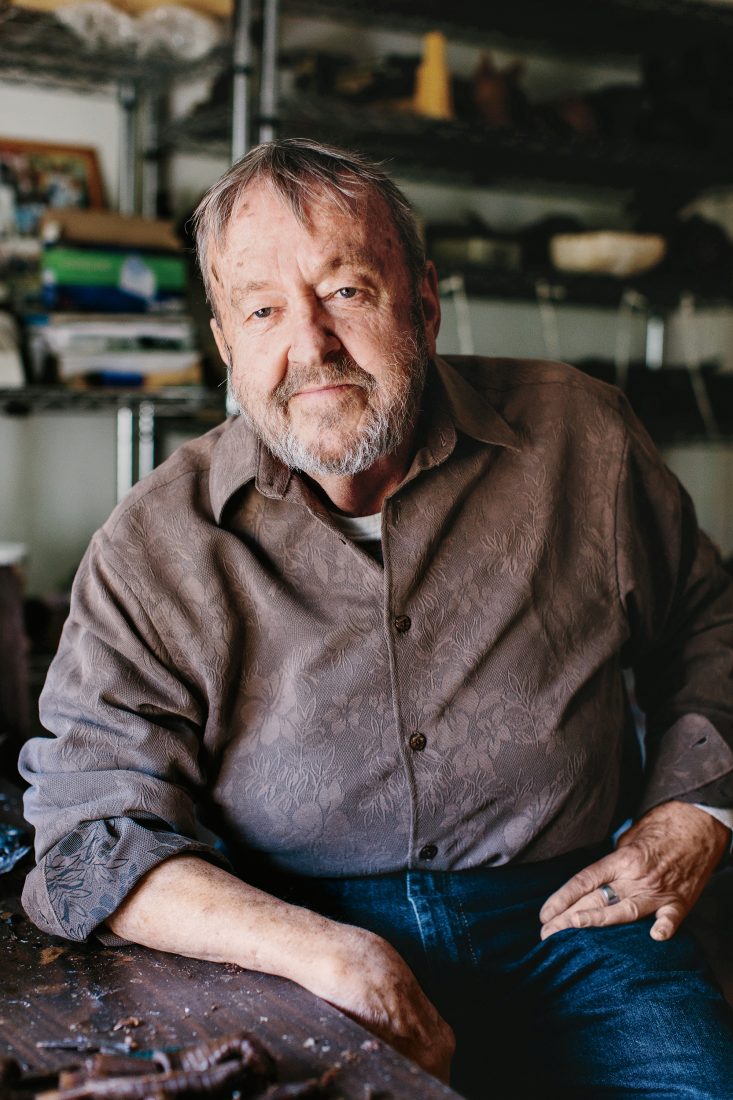
Photo: Andrew Thomas Lee
It’s Frank Fleming, of course, who spots the young lizard first. The reptile is as green as spring and lithe, tilting its diamond head at us from its perch on a hydrangea leaf. “Look at him,” Fleming says, and we drift into a minute of silence. The lizard’s black alien eyes stare into ours, but it doesn’t flee. Fleming leans forward for a better look, an expression of wonder lighting up his face. This is how Fleming studies animals—either in the wild, or in books and magazines or natural history museums. He can’t bear to see a caged beast in the zoo.
We are standing in his backyard garden, and the lizard is situated just behind one of Fleming’s sculptures: a porcelain rabbit with human hands and a strand of thorns curled round its neck. The piece has been outside long enough for moss to turn its grooves green. “This is one of those pieces I’ve just never understood,” Fleming says. “I never understood it when I was making it.” Lately, he dreams of taking some time—a year maybe—to sculpt only for himself again, to take a break from the bronze commissions and return to the medium and the imaginative space that gave life to this mysterious white rabbit. “I really have such a yearning to go back and do the clay pieces,” he says. “I love the feel of clay. Clay takes on more of a mythological thing.”
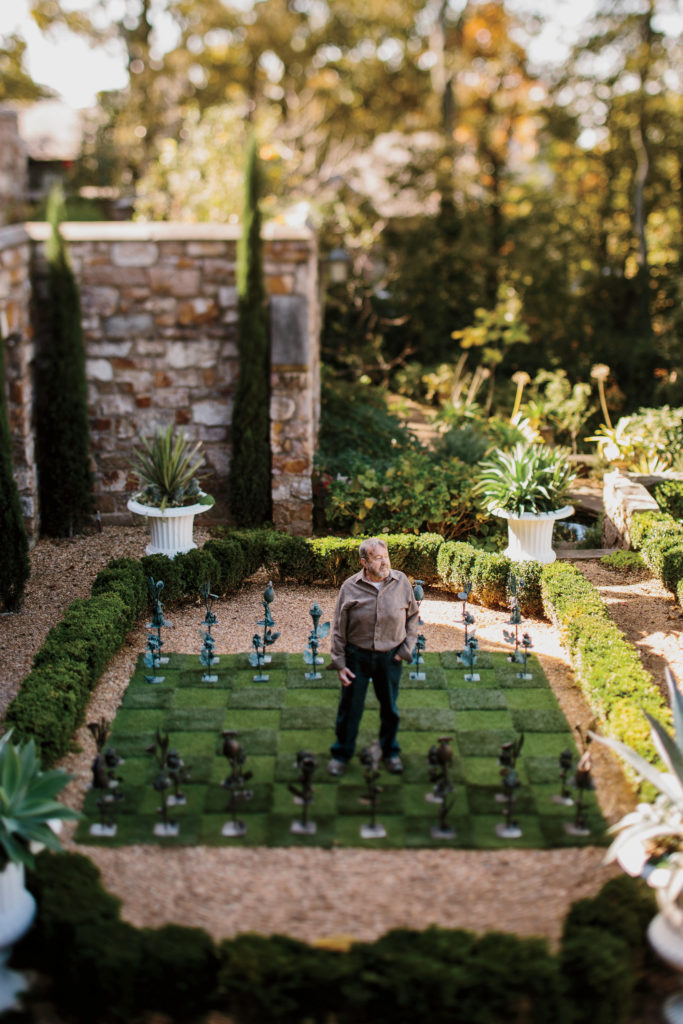
Photo: Andrew Thomas Lee
Garden Party
Fleming’s outdoor chess set, at the Swann House in Birmingham.
Inside Fleming’s one-story Birmingham home I find examples of his little myths. On an end table in a spare bedroom, one of Fleming’s porce-lain penguins from the eighties stands with human arms outstretched and a satchel slung across its shoulders. The bird is stark white and unglazed, a technique Fleming uses to emphasize form and theme. The creature looks both whimsical and unnervingly messianic. Nearby on a set of wire shelves, a clay lizard crawls across the palm of a hand that’s lost its fingertips; it’s meant to critique the transience of physical beauty. Fleming, who loves a sly joke, once tried to sell the sculpture in a gallery in Los Angeles.
The rest of the bedroom is filled with wax molds of elephants and tigers, calla lilies and songbirds, mallards and frogs. They’re the basis for the bronze sculptures that have made the Alabama artist famous. Fleming pauses in front of one, a rabbit seated on its haunches, and begins to laugh. He grabs a turtle mold and nestles it in the bunny’s arm. The effect is downright adorable. “This one is almost too sweet,” he says, “but someone will love it. It’s so awful it’s good.” Then he pauses and his eyes brighten above his beard. He starts laughing harder: “I should put a snake head on it biting the rabbit’s throat.”
Those who know Fleming only from his public art might be surprised by his dark humor. But it’s Fleming’s wit—and the way his sculptures of animals blur the line between man and beast—that have earned him more than eighty solo exhibits and a place in countless public and private collections, from the Smithsonian American Art Museum to the home of the late Jim Henson.
In Birmingham, Fleming is best known for the Storyteller, a public fountain in the Five Points South neighborhood that depicts a ram-man reading a book to a circle of woodland creatures. Most people see a charming storybook scene, but when it was installed in 1992, a few conspiracy theorists insisted that the ram-man, which sits with his back to a local church, symbolized Satan. “Everybody who knows Frank just laughed out loud,” says his friend Richard Dowd, who works at Littlehouse Galleries in Homewood. “He’s just such a nice guy.”
At seventy-three, Fleming moves slowly but still works constantly. Each weekday morning, he wakes for a 5:30 a.m. walk past the bungalows of his leafy neighborhood. Then he returns, sits down in his sunny studio, and sculpts until mid-afternoon. From his perch at the worktable, he can look out the window and see birds flitting through the yard. To his left, there’s a framed collection of black-and-white family photos; one image shows a gaggle of boys in overalls. It’s easy to pick Fleming out of the bunch: He’s just a little rounder than the rest, with an open smile that hasn’t changed in the intervening decades. Friends who have sat in this room and watched Fleming sculpt say he moves with intention and precision, like a watchmaker fixing a watch. Unlike most sculptors, Fleming doesn’t sketch his creations first. Drawing would make him feel like a copyist, as if pencil and paper had finished the piece before it could begin. Every object—the trippy bananas with legs, the mythical Minotaurs, the realistic rabbits—flows directly from Fleming’s imagination into three-dimensional existence. Working this way, he has completed between eight and ten thousand sculptures over the past forty years.
“It kind of just comes natural to him,” says Calvin Ross, a young artist who befriended Fleming several years ago and has come to consider the elder artist a mentor. “He has animals he likes and others he won’t do. I asked him once if he’d ever sculpted a dinosaur. He said he’s never seen a dinosaur so why would he want to sculpt one?”
For his part, Fleming would rather spend his Saturdays watching SEC football than perfecting artist’s statements to defend or explain his weird and wonderful work. He sculpts what pleases him. He likes art that makes him laugh. “It can just be done,” Fleming says. “It doesn’t have to have a reason. Many, many things, we have to have a reason behind it. Why? I don’t think you always have to ask, ‘Why turkey legs on an egg?’ you know?”
By the time Fleming started creating bronzes like the Storyteller, the artist already had a national reputation for ceramic sculpture. Fleming has done overtly political pieces, such as the grotesque Mr. Corn Tooth Politician, which portrays a man in a monkey mask squashing a frog beneath his heel. In the 1980s, Fleming also completed a series of pieces inspired by Guernica, Picasso’s anguished response to the Spanish Civil War. The results were so grim that a gallery owner in New York refused to show the sculptures; he thought they would upset customers at Christmastime. Fleming still keeps one, a three-foot-high “hand of destiny” wreathed by screaming bird–sea urchin hybrids, on his front steps.
Fleming transitioned from porcelain to bronze—and to gentler, more realistic subjects—primarily for financial stability. The material is durable enough for public spaces, and because he supports a brother and a disabled man who once worked as his assistant, commissions are important. Yet even Fleming’s lifelike rabbits, rats, and dogs stop short of being twee. There’s something haunting in their expressions. “There’s nothing worse than a cute animal,” he says. These animals have dignity.
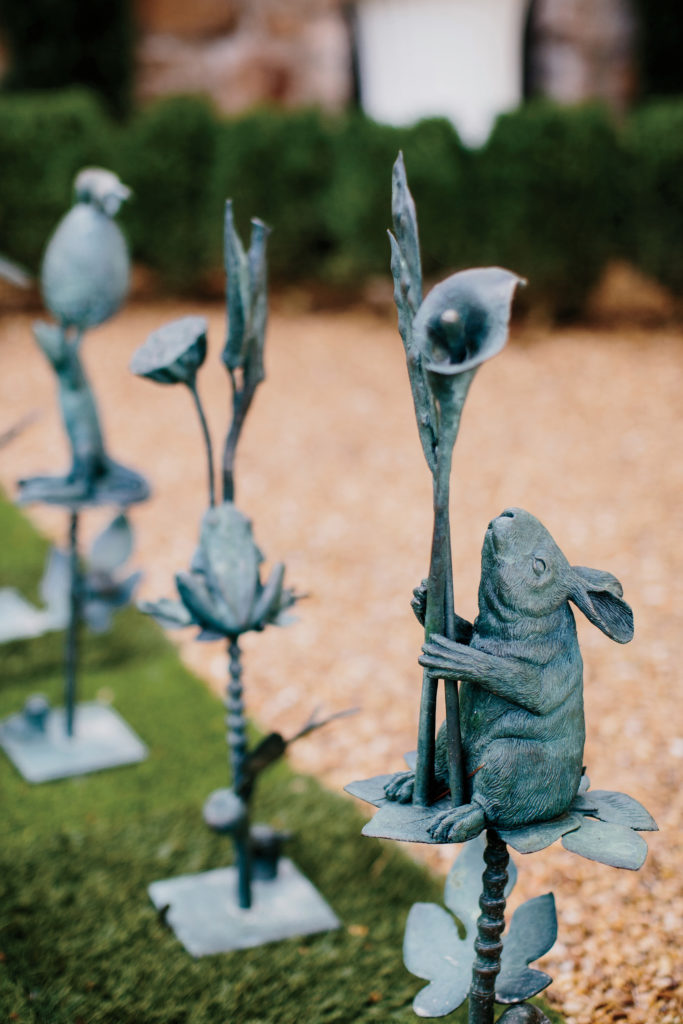
Photo: Andrew Thomas Lee
The intricately carved pieces.
Critics have described Fleming as a modern-day surrealist for the dreamy, fantastical quality of his work, but he doesn’t fit neatly under the standard art labels. His influences range from the midcentury Belgian painter and surrealist René Magritte to the anti-establishment California Funk artist Robert Arneson, who embraced figurative work and humor at a time when paint splashes on canvas ruled. Fleming calls himself a realist. But the author of a book on ceramics might have said it best. “This guy in this book called me a Southern freak,” Fleming says. “That’s the biggest compliment I’ve had.”
Fleming was born in Bear Creek, Alabama, in 1940, the fourth son of poor farmers. He had a father, five brothers, a sister, and a mother who could sew so beautifully that it was impossible to tell where one tiny stitch entered the fabric and the next came out. They lived on acres of rolling land cut by a creek and dotted by woods. They plowed with mules and grew their own vegetables. The children picked cotton by hand, a labor that Fleming has credited with developing the dexterity that would later help him excel as a sculptor. But while he loved being close to nature, Fleming faced an obstacle that none of his siblings had to endure. For him, forming words was inexplicably excruciating. Trying to answer a simple question would give him horrible headaches. For his entire childhood, Fleming was practically mute.
Fleming doesn’t remember receiving a precise diagnosis for his speech impediment, but he describes the problem as a block. “I think it was insecurities as a child,” he says. “I didn’t have a good relationship with my father, because I didn’t like macho things. My brothers played football and I was the team manager.” Fleming knew his disability embarrassed his parents. And the outside world could be cruel. A preacher once ordered the boy to say the benediction. Luckily, Fleming’s mama was nearby. She jumped up and said the prayer in her son’s place.
But what isolated Fleming also made him acutely sensitive to the natural world. In the afternoons, he would take the family dog, Corky, and drive the cows to the barn for the night. Along the way, he serenaded the herd with opera songs. Words came easily in the society of animals. He wasn’t embarrassed. No one laughed. “It was the most wonderful thing that has ever happened to me,” Fleming says. “Had I not been born that way, I would really be a different, not likable person, probably. I think that’s how God planned it for me to be an artist. He had a plan that was tough and bizarre sometimes, but it was a blessing.”
After high school, Fleming’s brothers all joined the navy or got manufacturing jobs. Only Fleming went to college, encouraged by an agriculture teacher who recognized the young man’s intelligence and knew his speech impediment could be treated. At Florence State College (now the University of North Alabama), Fleming enrolled in intensive speech therapy classes that sometimes lasted as long as eight hours. It took years, but as he gained confidence, he eventually learned to speak as well among herds of humans as he could among cows. Shortly after college he took a job in Huntsville as an illustrator at Boeing, where he spent most of his time doing lettering for flip charts. The work was dull, but the pay was so good that he splurged and bought a 1965 Porsche 912 for $5,000. In spite of the money, though, Fleming longed for a more creative way to express his talents. He started looking at art schools, but his GRE scores were so low that nobody wanted him.
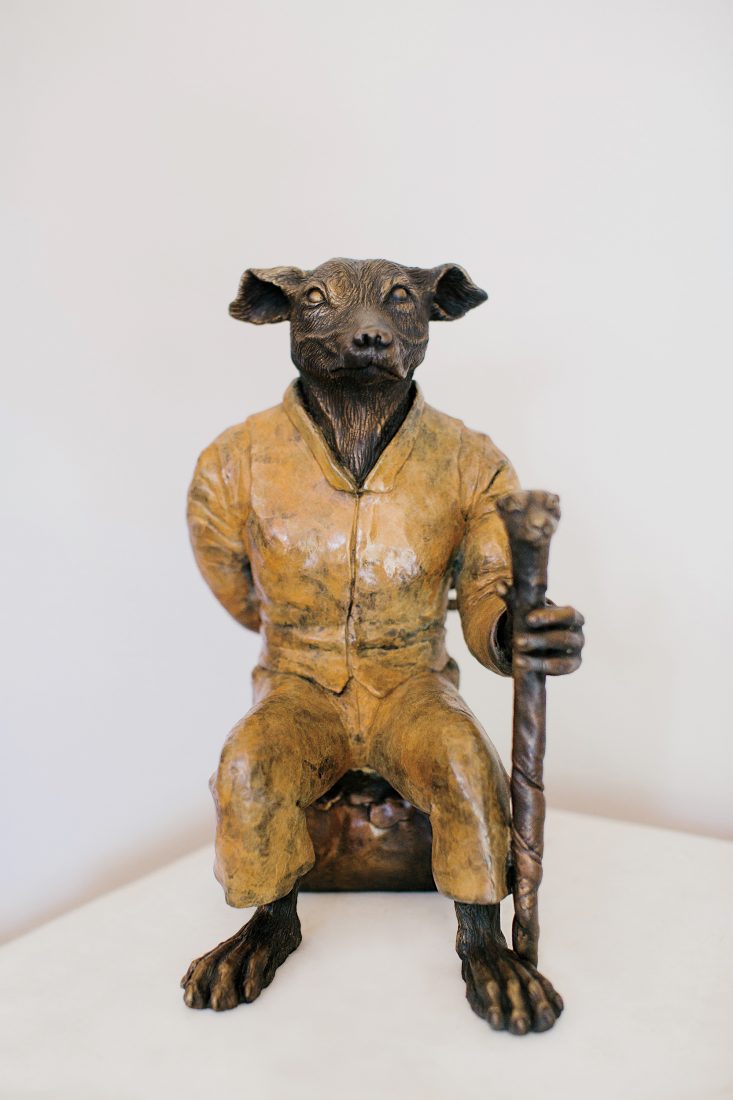
Photo: Andrew Thomas Lee
Fleming’s Dog Man (2008).
Eventually, the University of Alabama accepted Fleming into its MA program, and afterward, he considered pursuing an MFA under the artist Jerry Rothman at the University of Iowa. Fleming drove the Porsche to Iowa City but longed for Alabama the minute his loafers hit Midwestern soil. “I stayed two days and got so homesick,” he says. “I got in the car and headed South.” It would be the last time he considered moving away from the plants and the animals and the way of life that he loved.
Fleming did pursue his MFA, however, once the University of Alabama started offering that degree. At the time, abstract expressionism ruled. Sculptors in the abstract camp were preoccupied with nontraditional materials and techniques. Fleming’s professors didn’t like color. They didn’t like figures. They weren’t impressed when he began to experiment with realistic sculptures of vegetables and animals, or when he created anything that wasn’t brown. “They raked me over the coals,” he says. “They said, ‘You’re just doing that bad stuff. Do something serious.’” For his graduate exam, Fleming gave them what they wanted: a fifty-foot-wide pile of clay rocks. The memory still gives him the giggles. “They were brown,” he says. “They must have weighed tons and tons.” The faculty loved it.
His real art revelation came on a road trip to San Francisco in 1973. He and a few friends piled into a van and drove to an art show at the Palace of Fine Arts, where they marveled at sculptures by Funk artists Ron Nagle, David Gilhooly, and Marilyn Levine. Here was fine art that was funny (Gilhooly is best known for whimsical frogs) and unabashedly realistic (Levine sculpted handbags that looked exactly like leather). “That was an awakening,” he says. “I wouldn’t be where I am now if I hadn’t gone there and seen what could be done.”
And Fleming had an unusual faith in what he could do. After graduating, he stopped making brown rocks and turned to the “squarmints and gooney things” that would come to define him. He sold the Porsche and used the money to set up a studio in an unfinished office building in the Pelham suburb of Birmingham, where he applied his farm-boy work ethic to the production of fine art. Within months, he won first prize in a show juried by Arnold Glimcher, who owned the high-profile Pace Gallery in New York. Within a year, he had a show at the Birmingham Museum of Art. The museum served ice cream and beer on Sunday, and people thronged to see this Southern boy who had made good.
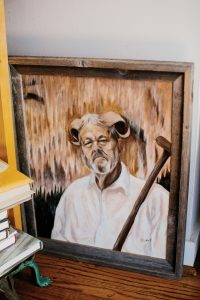
Photo: Andrew Thomas Lee
A painting of the artist by Calvin Ross.
But even after progressing from sidewalk sales to shows in Washington, D.C., and New York, he never developed an art ego. “There is no slush,” says a friend, Ken Jackson. “What you see is Frank Fleming. Some people would be different in front of the queen of England. Frank would be the same. Frank would probably wear a T-shirt.”
That’s exactly what he’s wearing today as we stand in his garden among okra and lilies and figs in a dozen or so raised beds. When he was younger, Fleming grew lilies as big as dinner plates in a garden that became legendary—Home & Garden Television once featured it in a show—and put up hundreds of cans of vegetables and jams each year. In 1980, his watermelon rind pickle won first prize at the Alabama State Fair, an accomplishment he once advertised on a poster for a sculpture show.
“I think once you know that he gardens, you see the organic part of his sculpture,” says Richard Dowd, one of Fleming’s few longtime friends. “You see it’s not rigid or mechanical. It all relates back to the earth in some form or another.”
Fleming has lived alone almost all his adult life. His deepest thoughts will probably always remain as mysterious as his art, though he did share his life with an animal once, a mutt named Bones, whom you can still see in a framed photograph propped against his living room wall. After Bones’s death thirty-one years ago, Fleming could never bring himself to own another pet. The loss was too painful, and he felt guilty that he sometimes paid more attention to work and social duties than to Bones. “That bothers me,” he says. “I think animals are people who come back. I have a recurring dream of me being a bird that soars.”


